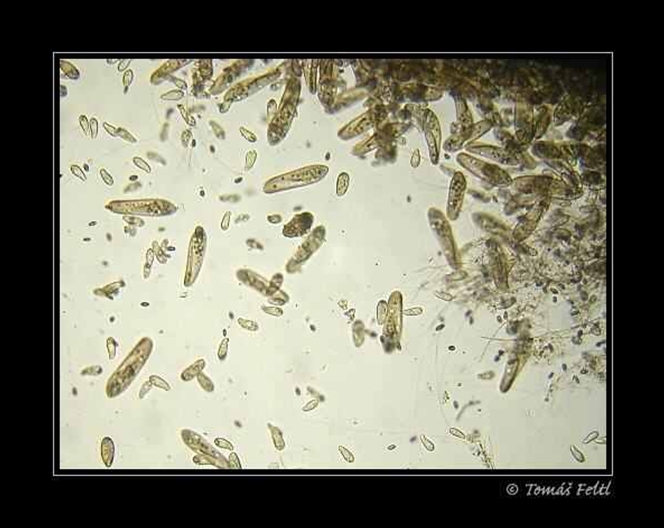| Learning Aims: |
|
| Materials: |
|
| Suggestions for use: |
|
Task 1: First, students discuss the osmotic phenomena in the cell. Then they will be provided with worksheet tasks. Note: The teacher is recommended to prepare a hay infusion. a) Formulate a research problem about the process of production of final urine. Research problem: Will a cell of paramoecium in salty (hypertonic) environment lose or suck water? b) Establish your hypothesis about the manner of final urine production and justify your assumption. Hypothesis: The cell of paramoecium will lose water in salty (hypertonic) environment and it will shrink. Justification: The cell of paramoecium loses water in salty (hypertonic) environment as it tries to dilute it. c) Propose tools to use during your experiment and justify your selection. Tools: hay infusion, microscope, slides and cover glass, pipette, two beakers, tap water (distilled water), salt (NaCl) Justification: hay infusion as a source of ciliates, aids for microscopy are necessary for the preparation and observation of microscopic slides, beakers to hold demonstration material and to prepare a saline solution, salt is used to prepare the saline solution, water to prepare aqueous environment d) Think of the experiment procedure and record it step by step. Add a small drop of rich culture of paramoecium on the slide glass. Cover with a cover glass and observe. Then add a drop of saline solution (10% solution of NaCl) and observe once more.
Source: http://www.tfsoft.cz/photo/detail.php?a=700&p=1&f=343&rc=6 Now go back to your hypothesis. Has it been proved or disproved by the results of the experiment? The hypothesis has been proved on the basis of the experiment performed. The cell of paramoecium was losing water after adding the saline solution and it shrank. Task 2: Students can find the pictures of the respective parts of nephron in the Internet*. Students will define the answers to the respective parts of the task in the worksheet. Then they will verify their correctness in the scientific literature or in the Internet, where they search for the correct answers. a) Proximal tubule This section is well permeable for both water and salt. Resorption of water is passive after transtubular osmotic gradient that forms active resorptions of sodium and other solutes. Water diffuses through the tubular cells and accumulates in the peritubular area, which increases the hydrostatic pressure in this area; this change in capillary forces then leads to resorption of water into the peritubular capillaries. Absorption of water and solutes in the proximal tubule is proportional, i.e. fluid leaving the proximal tubules is isoosmolar, and creates approximately 70 % of volume filtered in glomeruli. b) Loop of Henle The thin descending part of Loop of Henle is permeable to water that is resorbed here in about 15%, but is not permeable to salt. The driving force for again passive resorption of water is hyperosmolarity of kidney marrow. The ascending part of Loop of Henle (thin and thick) is impermeable to water, but, on the contrary, permeable to NaCl. The resorption of salt therefore occurs in the ascending limb of Loop of Henle, i.e. passively in the thin part and actively in the thick part where the sodium is resorbed along with potassium and chlorides. Salt re - absorption in the ascending loop reaches 20% of the total amount of ultrafiltrate. The fluid leaving the Loop of Henle is hypoosmolar because the resorption of solutes in this section prevails over resorption of water. c) Distal tubule and collecting duct A coiled portion of the distal tubule is impermeable to water; the resorption of salt here is active. The end of the distal tubule is the place where both water and salt may or may not undergo resorption; this part is under the hormonal control. A usual amount of water and salt resorbed through distal tubules is about 5 %. Urine leaving the distal tubule remains hypoosmolar. A collecting duct is responsible for final treatment of urine according to the needs of the organism. Backward resorption of water is here under the hormonal control of ADH, which opens for water the aqua channels (aquaporins) in the apical membrane. Without ADH, the collecting duct is impermeable to water. Backward resorption of sodium in the collecting ducts is under the hormonal control of aldosterone, which stimulates its re-absorption via epithelial sodium channel. The collecting ducts usually resorb about 4 % of filtered sodium and about 9 % of filtered water. Source: http://pfyziollfup.upol.cz/castwiki2/?p=5063 *These pictures can be found on the website such as: http://pfyziollfup.upol.cz/castwiki2/?p=3695, http://science.kennesaw.edu/~jdirnber/Bio2108/Lecture/LecPhysio/PhysioExcretory.html, http://www.engin.umich.edu/~cre/web_mod/viper/kidney_function.htm |
| Possible questions: |
|
